Organisational Behaviour and Leadership: CAPCO Report Analysis
VerifiedAdded on 2020/01/28
|14
|5137
|63
Report
AI Summary
This report provides a comprehensive analysis of organisational behaviour within Capco, a global business and technology consultancy. It begins by comparing and contrasting Capco's flat organisational structure and role-based culture with another organization, examining the impact of structure and culture on operational performance, communication, delegation, financial results, and customer satisfaction. The report then explores the factors influencing individual behaviour, including leadership styles, working conditions, and assigned work. Different leadership styles at Capco, including democratic, transactional, and autocratic approaches, are evaluated, alongside the impact of organizational theories, such as scientific management and human relations, on management practices. Motivational theories and their impact on employee engagement are compared, and the significance of applying these theories in the workplace is discussed. The report concludes with an examination of group dynamics, factors affecting teamwork, and the influence of technology on team functioning within Capco.
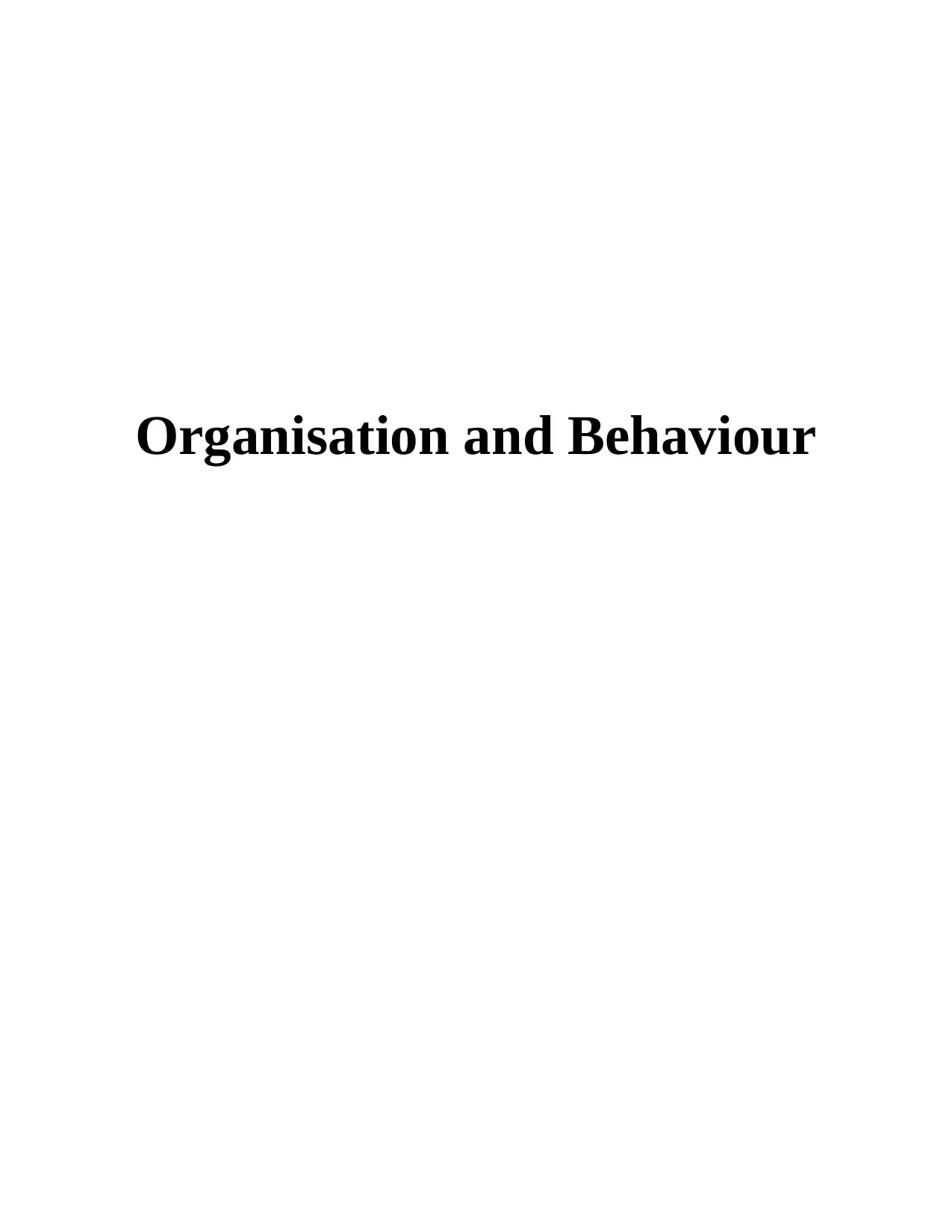
Organisation and Behaviour
Paraphrase This Document
Need a fresh take? Get an instant paraphrase of this document with our AI Paraphraser
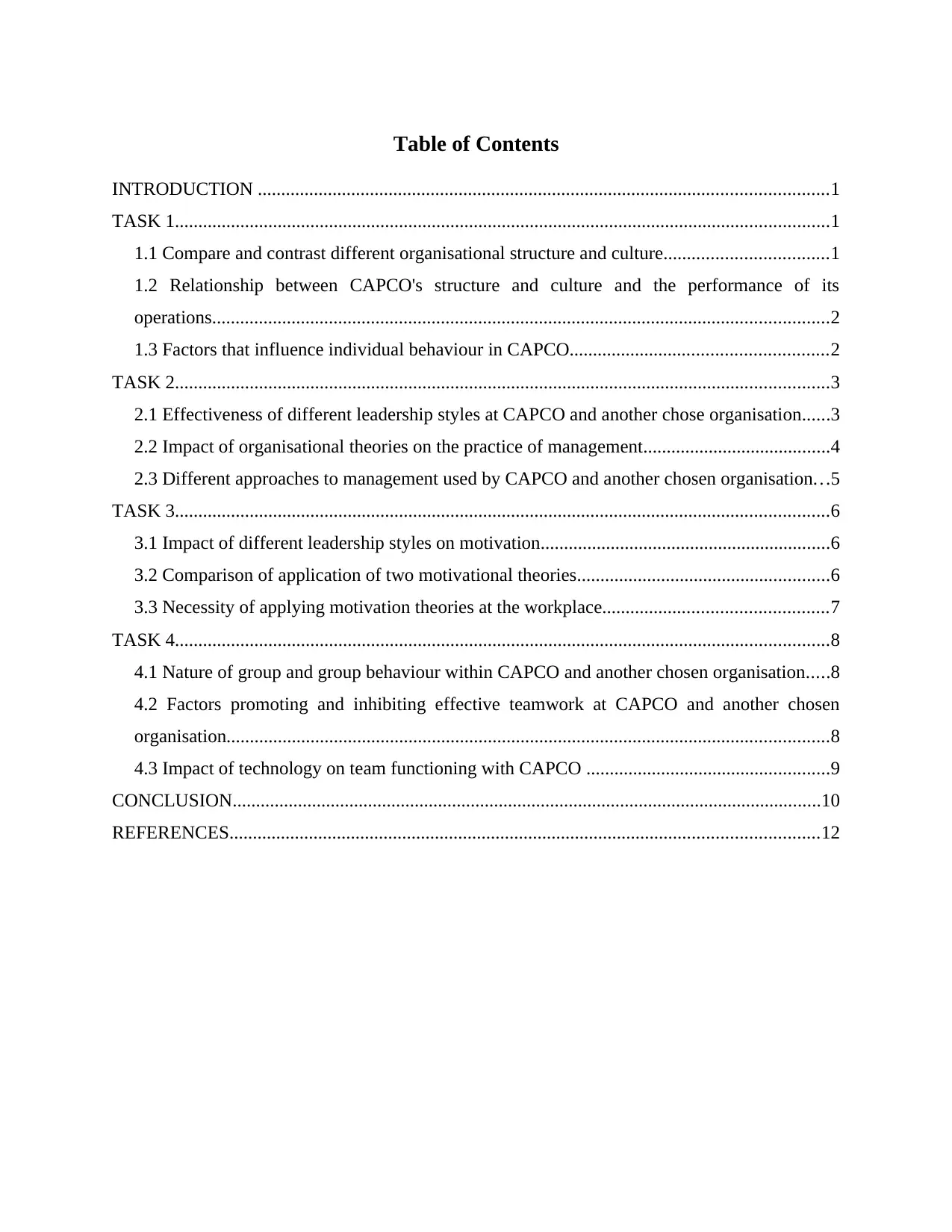
Table of Contents
INTRODUCTION ..........................................................................................................................1
TASK 1............................................................................................................................................1
1.1 Compare and contrast different organisational structure and culture...................................1
1.2 Relationship between CAPCO's structure and culture and the performance of its
operations....................................................................................................................................2
1.3 Factors that influence individual behaviour in CAPCO.......................................................2
TASK 2............................................................................................................................................3
2.1 Effectiveness of different leadership styles at CAPCO and another chose organisation......3
2.2 Impact of organisational theories on the practice of management........................................4
2.3 Different approaches to management used by CAPCO and another chosen organisation...5
TASK 3............................................................................................................................................6
3.1 Impact of different leadership styles on motivation..............................................................6
3.2 Comparison of application of two motivational theories......................................................6
3.3 Necessity of applying motivation theories at the workplace................................................7
TASK 4............................................................................................................................................8
4.1 Nature of group and group behaviour within CAPCO and another chosen organisation.....8
4.2 Factors promoting and inhibiting effective teamwork at CAPCO and another chosen
organisation.................................................................................................................................8
4.3 Impact of technology on team functioning with CAPCO ....................................................9
CONCLUSION..............................................................................................................................10
REFERENCES..............................................................................................................................12
INTRODUCTION ..........................................................................................................................1
TASK 1............................................................................................................................................1
1.1 Compare and contrast different organisational structure and culture...................................1
1.2 Relationship between CAPCO's structure and culture and the performance of its
operations....................................................................................................................................2
1.3 Factors that influence individual behaviour in CAPCO.......................................................2
TASK 2............................................................................................................................................3
2.1 Effectiveness of different leadership styles at CAPCO and another chose organisation......3
2.2 Impact of organisational theories on the practice of management........................................4
2.3 Different approaches to management used by CAPCO and another chosen organisation...5
TASK 3............................................................................................................................................6
3.1 Impact of different leadership styles on motivation..............................................................6
3.2 Comparison of application of two motivational theories......................................................6
3.3 Necessity of applying motivation theories at the workplace................................................7
TASK 4............................................................................................................................................8
4.1 Nature of group and group behaviour within CAPCO and another chosen organisation.....8
4.2 Factors promoting and inhibiting effective teamwork at CAPCO and another chosen
organisation.................................................................................................................................8
4.3 Impact of technology on team functioning with CAPCO ....................................................9
CONCLUSION..............................................................................................................................10
REFERENCES..............................................................................................................................12
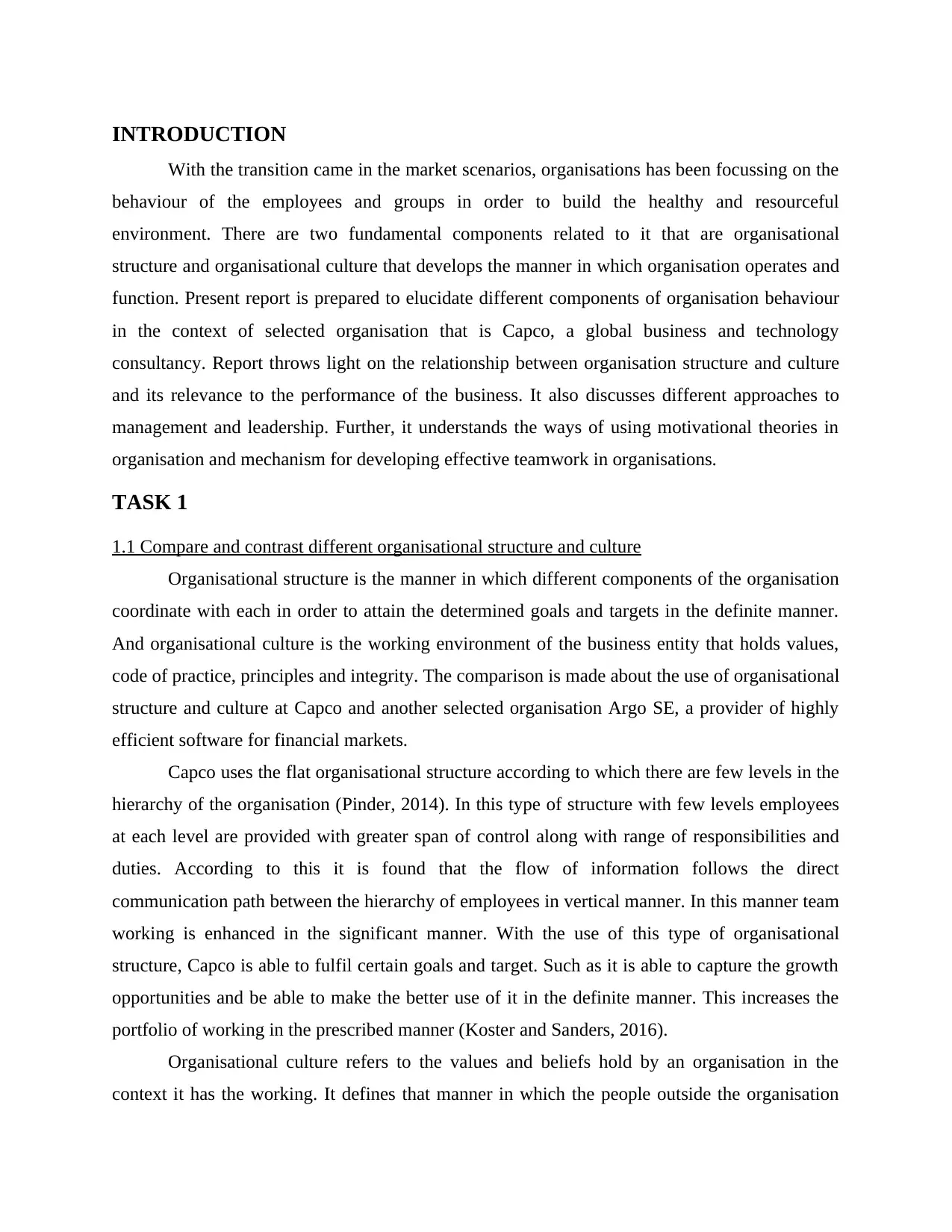
INTRODUCTION
With the transition came in the market scenarios, organisations has been focussing on the
behaviour of the employees and groups in order to build the healthy and resourceful
environment. There are two fundamental components related to it that are organisational
structure and organisational culture that develops the manner in which organisation operates and
function. Present report is prepared to elucidate different components of organisation behaviour
in the context of selected organisation that is Capco, a global business and technology
consultancy. Report throws light on the relationship between organisation structure and culture
and its relevance to the performance of the business. It also discusses different approaches to
management and leadership. Further, it understands the ways of using motivational theories in
organisation and mechanism for developing effective teamwork in organisations.
TASK 1
1.1 Compare and contrast different organisational structure and culture
Organisational structure is the manner in which different components of the organisation
coordinate with each in order to attain the determined goals and targets in the definite manner.
And organisational culture is the working environment of the business entity that holds values,
code of practice, principles and integrity. The comparison is made about the use of organisational
structure and culture at Capco and another selected organisation Argo SE, a provider of highly
efficient software for financial markets.
Capco uses the flat organisational structure according to which there are few levels in the
hierarchy of the organisation (Pinder, 2014). In this type of structure with few levels employees
at each level are provided with greater span of control along with range of responsibilities and
duties. According to this it is found that the flow of information follows the direct
communication path between the hierarchy of employees in vertical manner. In this manner team
working is enhanced in the significant manner. With the use of this type of organisational
structure, Capco is able to fulfil certain goals and target. Such as it is able to capture the growth
opportunities and be able to make the better use of it in the definite manner. This increases the
portfolio of working in the prescribed manner (Koster and Sanders, 2016).
Organisational culture refers to the values and beliefs hold by an organisation in the
context it has the working. It defines that manner in which the people outside the organisation
With the transition came in the market scenarios, organisations has been focussing on the
behaviour of the employees and groups in order to build the healthy and resourceful
environment. There are two fundamental components related to it that are organisational
structure and organisational culture that develops the manner in which organisation operates and
function. Present report is prepared to elucidate different components of organisation behaviour
in the context of selected organisation that is Capco, a global business and technology
consultancy. Report throws light on the relationship between organisation structure and culture
and its relevance to the performance of the business. It also discusses different approaches to
management and leadership. Further, it understands the ways of using motivational theories in
organisation and mechanism for developing effective teamwork in organisations.
TASK 1
1.1 Compare and contrast different organisational structure and culture
Organisational structure is the manner in which different components of the organisation
coordinate with each in order to attain the determined goals and targets in the definite manner.
And organisational culture is the working environment of the business entity that holds values,
code of practice, principles and integrity. The comparison is made about the use of organisational
structure and culture at Capco and another selected organisation Argo SE, a provider of highly
efficient software for financial markets.
Capco uses the flat organisational structure according to which there are few levels in the
hierarchy of the organisation (Pinder, 2014). In this type of structure with few levels employees
at each level are provided with greater span of control along with range of responsibilities and
duties. According to this it is found that the flow of information follows the direct
communication path between the hierarchy of employees in vertical manner. In this manner team
working is enhanced in the significant manner. With the use of this type of organisational
structure, Capco is able to fulfil certain goals and target. Such as it is able to capture the growth
opportunities and be able to make the better use of it in the definite manner. This increases the
portfolio of working in the prescribed manner (Koster and Sanders, 2016).
Organisational culture refers to the values and beliefs hold by an organisation in the
context it has the working. It defines that manner in which the people outside the organisation
⊘ This is a preview!⊘
Do you want full access?
Subscribe today to unlock all pages.

Trusted by 1+ million students worldwide
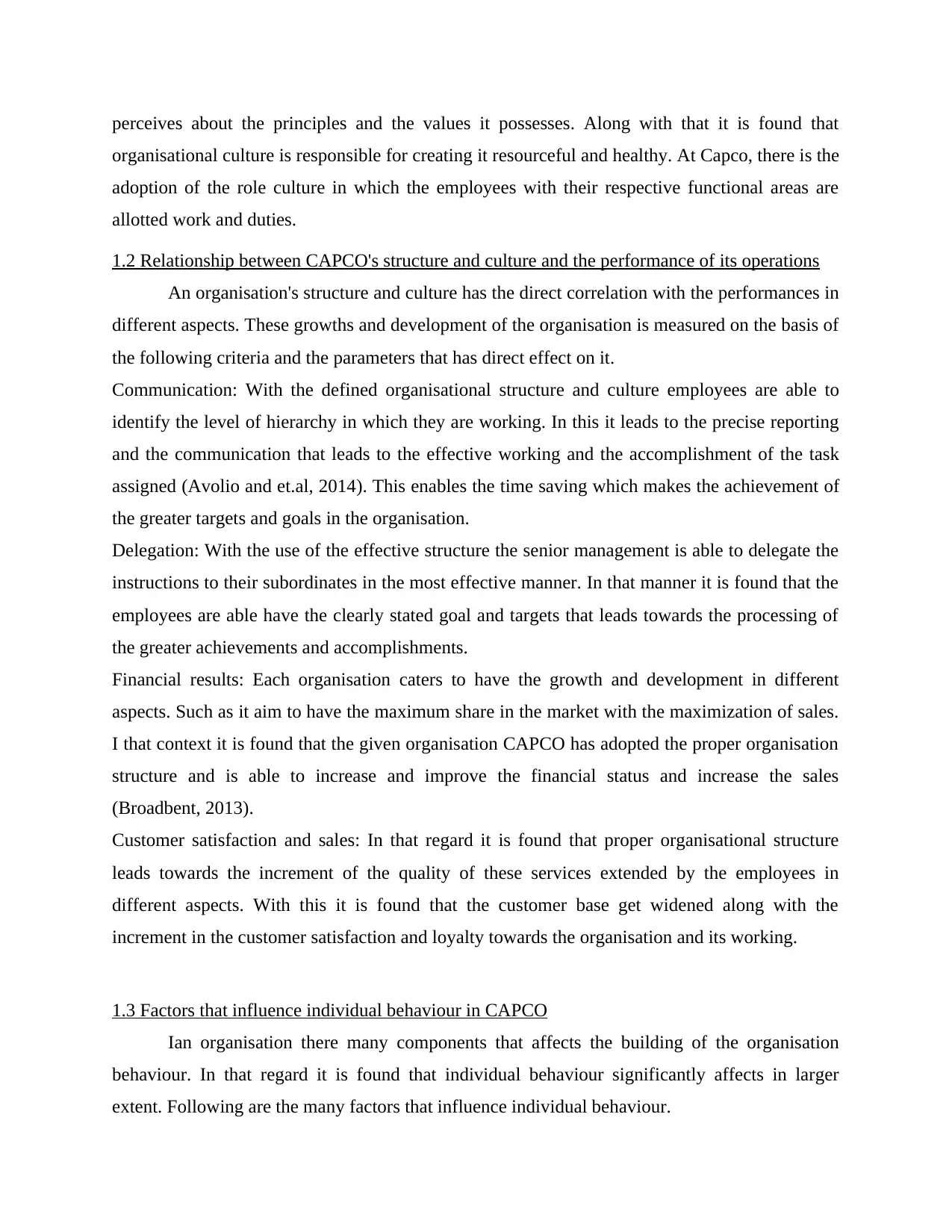
perceives about the principles and the values it possesses. Along with that it is found that
organisational culture is responsible for creating it resourceful and healthy. At Capco, there is the
adoption of the role culture in which the employees with their respective functional areas are
allotted work and duties.
1.2 Relationship between CAPCO's structure and culture and the performance of its operations
An organisation's structure and culture has the direct correlation with the performances in
different aspects. These growths and development of the organisation is measured on the basis of
the following criteria and the parameters that has direct effect on it.
Communication: With the defined organisational structure and culture employees are able to
identify the level of hierarchy in which they are working. In this it leads to the precise reporting
and the communication that leads to the effective working and the accomplishment of the task
assigned (Avolio and et.al, 2014). This enables the time saving which makes the achievement of
the greater targets and goals in the organisation.
Delegation: With the use of the effective structure the senior management is able to delegate the
instructions to their subordinates in the most effective manner. In that manner it is found that the
employees are able have the clearly stated goal and targets that leads towards the processing of
the greater achievements and accomplishments.
Financial results: Each organisation caters to have the growth and development in different
aspects. Such as it aim to have the maximum share in the market with the maximization of sales.
I that context it is found that the given organisation CAPCO has adopted the proper organisation
structure and is able to increase and improve the financial status and increase the sales
(Broadbent, 2013).
Customer satisfaction and sales: In that regard it is found that proper organisational structure
leads towards the increment of the quality of these services extended by the employees in
different aspects. With this it is found that the customer base get widened along with the
increment in the customer satisfaction and loyalty towards the organisation and its working.
1.3 Factors that influence individual behaviour in CAPCO
Ian organisation there many components that affects the building of the organisation
behaviour. In that regard it is found that individual behaviour significantly affects in larger
extent. Following are the many factors that influence individual behaviour.
organisational culture is responsible for creating it resourceful and healthy. At Capco, there is the
adoption of the role culture in which the employees with their respective functional areas are
allotted work and duties.
1.2 Relationship between CAPCO's structure and culture and the performance of its operations
An organisation's structure and culture has the direct correlation with the performances in
different aspects. These growths and development of the organisation is measured on the basis of
the following criteria and the parameters that has direct effect on it.
Communication: With the defined organisational structure and culture employees are able to
identify the level of hierarchy in which they are working. In this it leads to the precise reporting
and the communication that leads to the effective working and the accomplishment of the task
assigned (Avolio and et.al, 2014). This enables the time saving which makes the achievement of
the greater targets and goals in the organisation.
Delegation: With the use of the effective structure the senior management is able to delegate the
instructions to their subordinates in the most effective manner. In that manner it is found that the
employees are able have the clearly stated goal and targets that leads towards the processing of
the greater achievements and accomplishments.
Financial results: Each organisation caters to have the growth and development in different
aspects. Such as it aim to have the maximum share in the market with the maximization of sales.
I that context it is found that the given organisation CAPCO has adopted the proper organisation
structure and is able to increase and improve the financial status and increase the sales
(Broadbent, 2013).
Customer satisfaction and sales: In that regard it is found that proper organisational structure
leads towards the increment of the quality of these services extended by the employees in
different aspects. With this it is found that the customer base get widened along with the
increment in the customer satisfaction and loyalty towards the organisation and its working.
1.3 Factors that influence individual behaviour in CAPCO
Ian organisation there many components that affects the building of the organisation
behaviour. In that regard it is found that individual behaviour significantly affects in larger
extent. Following are the many factors that influence individual behaviour.
Paraphrase This Document
Need a fresh take? Get an instant paraphrase of this document with our AI Paraphraser
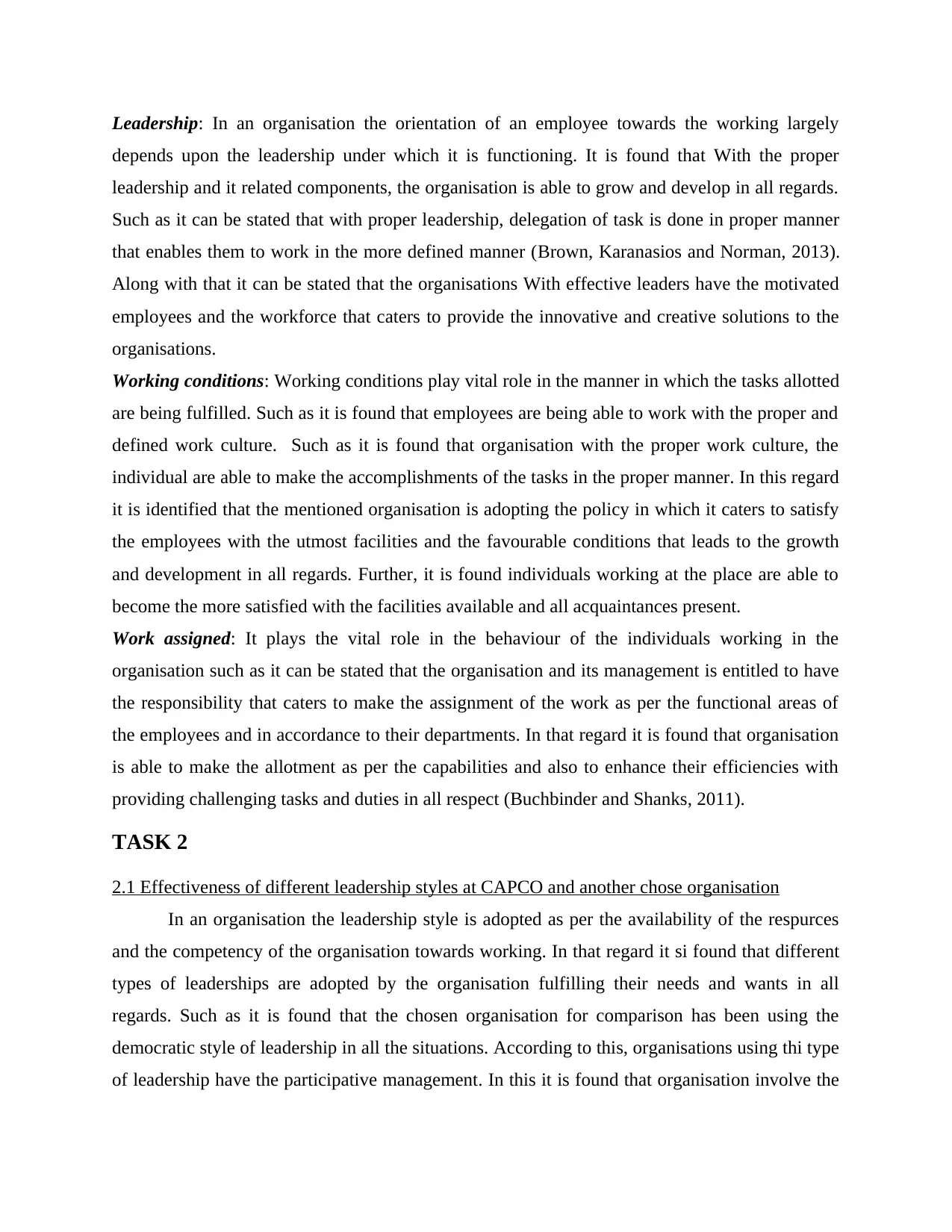
Leadership: In an organisation the orientation of an employee towards the working largely
depends upon the leadership under which it is functioning. It is found that With the proper
leadership and it related components, the organisation is able to grow and develop in all regards.
Such as it can be stated that with proper leadership, delegation of task is done in proper manner
that enables them to work in the more defined manner (Brown, Karanasios and Norman, 2013).
Along with that it can be stated that the organisations With effective leaders have the motivated
employees and the workforce that caters to provide the innovative and creative solutions to the
organisations.
Working conditions: Working conditions play vital role in the manner in which the tasks allotted
are being fulfilled. Such as it is found that employees are being able to work with the proper and
defined work culture. Such as it is found that organisation with the proper work culture, the
individual are able to make the accomplishments of the tasks in the proper manner. In this regard
it is identified that the mentioned organisation is adopting the policy in which it caters to satisfy
the employees with the utmost facilities and the favourable conditions that leads to the growth
and development in all regards. Further, it is found individuals working at the place are able to
become the more satisfied with the facilities available and all acquaintances present.
Work assigned: It plays the vital role in the behaviour of the individuals working in the
organisation such as it can be stated that the organisation and its management is entitled to have
the responsibility that caters to make the assignment of the work as per the functional areas of
the employees and in accordance to their departments. In that regard it is found that organisation
is able to make the allotment as per the capabilities and also to enhance their efficiencies with
providing challenging tasks and duties in all respect (Buchbinder and Shanks, 2011).
TASK 2
2.1 Effectiveness of different leadership styles at CAPCO and another chose organisation
In an organisation the leadership style is adopted as per the availability of the respurces
and the competency of the organisation towards working. In that regard it si found that different
types of leaderships are adopted by the organisation fulfilling their needs and wants in all
regards. Such as it is found that the chosen organisation for comparison has been using the
democratic style of leadership in all the situations. According to this, organisations using thi type
of leadership have the participative management. In this it is found that organisation involve the
depends upon the leadership under which it is functioning. It is found that With the proper
leadership and it related components, the organisation is able to grow and develop in all regards.
Such as it can be stated that with proper leadership, delegation of task is done in proper manner
that enables them to work in the more defined manner (Brown, Karanasios and Norman, 2013).
Along with that it can be stated that the organisations With effective leaders have the motivated
employees and the workforce that caters to provide the innovative and creative solutions to the
organisations.
Working conditions: Working conditions play vital role in the manner in which the tasks allotted
are being fulfilled. Such as it is found that employees are being able to work with the proper and
defined work culture. Such as it is found that organisation with the proper work culture, the
individual are able to make the accomplishments of the tasks in the proper manner. In this regard
it is identified that the mentioned organisation is adopting the policy in which it caters to satisfy
the employees with the utmost facilities and the favourable conditions that leads to the growth
and development in all regards. Further, it is found individuals working at the place are able to
become the more satisfied with the facilities available and all acquaintances present.
Work assigned: It plays the vital role in the behaviour of the individuals working in the
organisation such as it can be stated that the organisation and its management is entitled to have
the responsibility that caters to make the assignment of the work as per the functional areas of
the employees and in accordance to their departments. In that regard it is found that organisation
is able to make the allotment as per the capabilities and also to enhance their efficiencies with
providing challenging tasks and duties in all respect (Buchbinder and Shanks, 2011).
TASK 2
2.1 Effectiveness of different leadership styles at CAPCO and another chose organisation
In an organisation the leadership style is adopted as per the availability of the respurces
and the competency of the organisation towards working. In that regard it si found that different
types of leaderships are adopted by the organisation fulfilling their needs and wants in all
regards. Such as it is found that the chosen organisation for comparison has been using the
democratic style of leadership in all the situations. According to this, organisations using thi type
of leadership have the participative management. In this it is found that organisation involve the
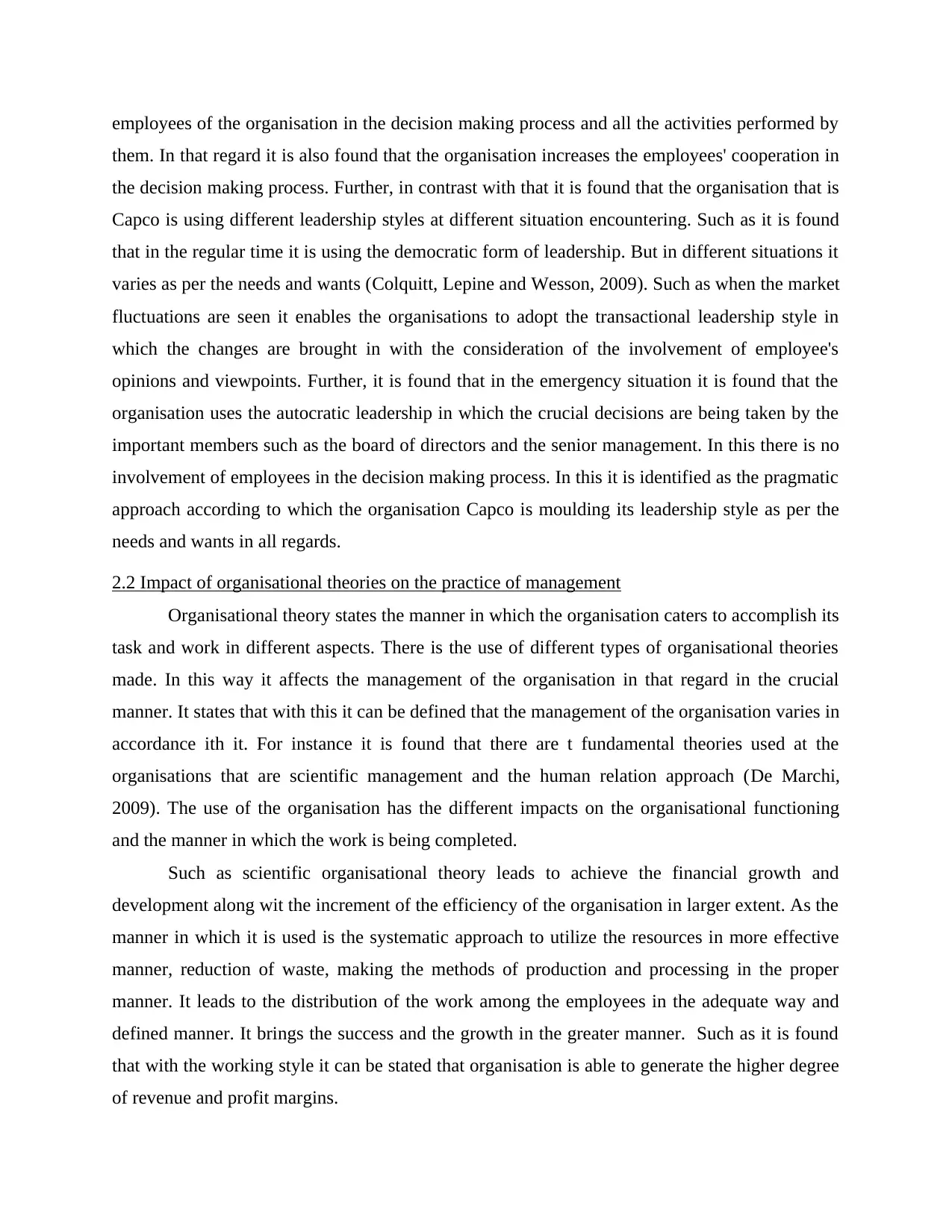
employees of the organisation in the decision making process and all the activities performed by
them. In that regard it is also found that the organisation increases the employees' cooperation in
the decision making process. Further, in contrast with that it is found that the organisation that is
Capco is using different leadership styles at different situation encountering. Such as it is found
that in the regular time it is using the democratic form of leadership. But in different situations it
varies as per the needs and wants (Colquitt, Lepine and Wesson, 2009). Such as when the market
fluctuations are seen it enables the organisations to adopt the transactional leadership style in
which the changes are brought in with the consideration of the involvement of employee's
opinions and viewpoints. Further, it is found that in the emergency situation it is found that the
organisation uses the autocratic leadership in which the crucial decisions are being taken by the
important members such as the board of directors and the senior management. In this there is no
involvement of employees in the decision making process. In this it is identified as the pragmatic
approach according to which the organisation Capco is moulding its leadership style as per the
needs and wants in all regards.
2.2 Impact of organisational theories on the practice of management
Organisational theory states the manner in which the organisation caters to accomplish its
task and work in different aspects. There is the use of different types of organisational theories
made. In this way it affects the management of the organisation in that regard in the crucial
manner. It states that with this it can be defined that the management of the organisation varies in
accordance ith it. For instance it is found that there are t fundamental theories used at the
organisations that are scientific management and the human relation approach (De Marchi,
2009). The use of the organisation has the different impacts on the organisational functioning
and the manner in which the work is being completed.
Such as scientific organisational theory leads to achieve the financial growth and
development along wit the increment of the efficiency of the organisation in larger extent. As the
manner in which it is used is the systematic approach to utilize the resources in more effective
manner, reduction of waste, making the methods of production and processing in the proper
manner. It leads to the distribution of the work among the employees in the adequate way and
defined manner. It brings the success and the growth in the greater manner. Such as it is found
that with the working style it can be stated that organisation is able to generate the higher degree
of revenue and profit margins.
them. In that regard it is also found that the organisation increases the employees' cooperation in
the decision making process. Further, in contrast with that it is found that the organisation that is
Capco is using different leadership styles at different situation encountering. Such as it is found
that in the regular time it is using the democratic form of leadership. But in different situations it
varies as per the needs and wants (Colquitt, Lepine and Wesson, 2009). Such as when the market
fluctuations are seen it enables the organisations to adopt the transactional leadership style in
which the changes are brought in with the consideration of the involvement of employee's
opinions and viewpoints. Further, it is found that in the emergency situation it is found that the
organisation uses the autocratic leadership in which the crucial decisions are being taken by the
important members such as the board of directors and the senior management. In this there is no
involvement of employees in the decision making process. In this it is identified as the pragmatic
approach according to which the organisation Capco is moulding its leadership style as per the
needs and wants in all regards.
2.2 Impact of organisational theories on the practice of management
Organisational theory states the manner in which the organisation caters to accomplish its
task and work in different aspects. There is the use of different types of organisational theories
made. In this way it affects the management of the organisation in that regard in the crucial
manner. It states that with this it can be defined that the management of the organisation varies in
accordance ith it. For instance it is found that there are t fundamental theories used at the
organisations that are scientific management and the human relation approach (De Marchi,
2009). The use of the organisation has the different impacts on the organisational functioning
and the manner in which the work is being completed.
Such as scientific organisational theory leads to achieve the financial growth and
development along wit the increment of the efficiency of the organisation in larger extent. As the
manner in which it is used is the systematic approach to utilize the resources in more effective
manner, reduction of waste, making the methods of production and processing in the proper
manner. It leads to the distribution of the work among the employees in the adequate way and
defined manner. It brings the success and the growth in the greater manner. Such as it is found
that with the working style it can be stated that organisation is able to generate the higher degree
of revenue and profit margins.
⊘ This is a preview!⊘
Do you want full access?
Subscribe today to unlock all pages.

Trusted by 1+ million students worldwide
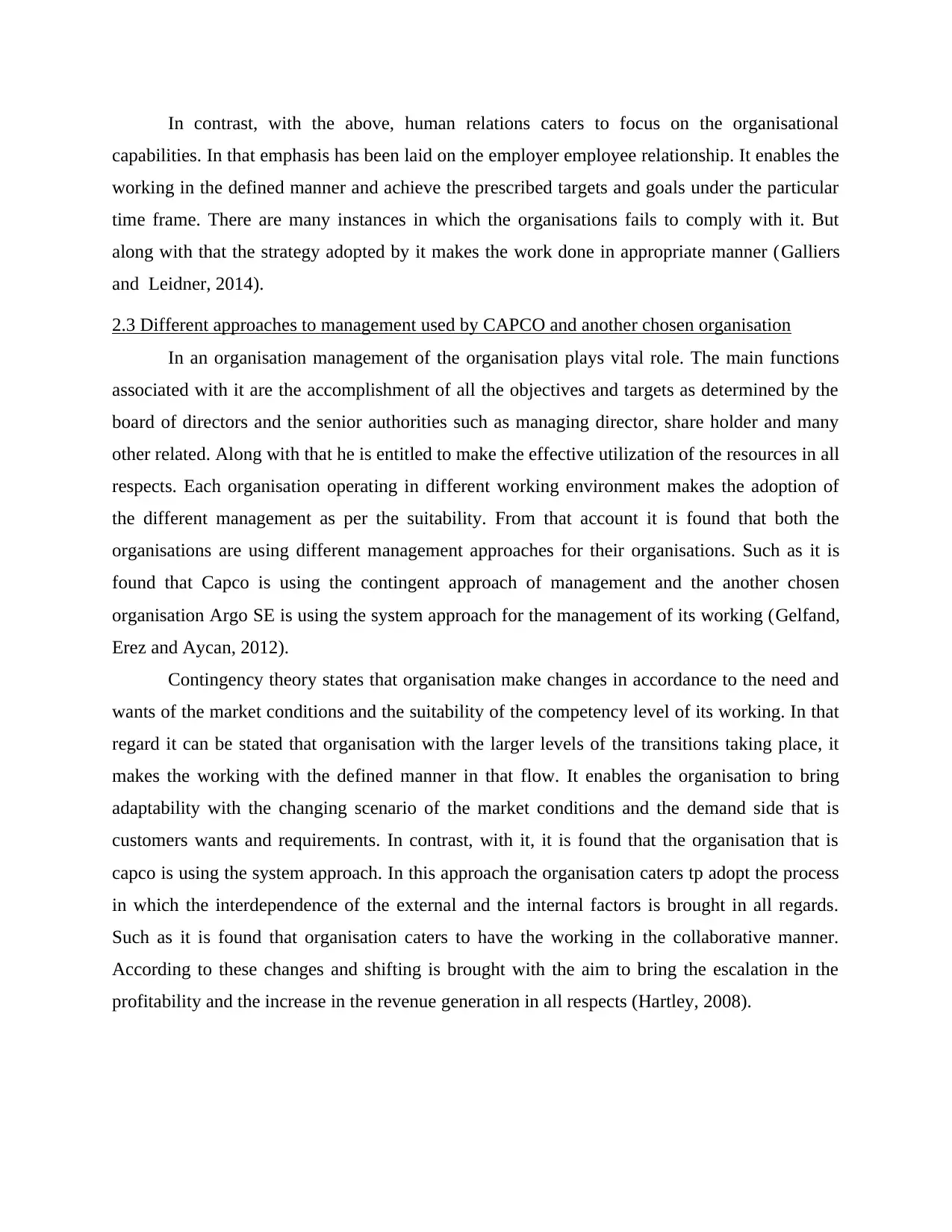
In contrast, with the above, human relations caters to focus on the organisational
capabilities. In that emphasis has been laid on the employer employee relationship. It enables the
working in the defined manner and achieve the prescribed targets and goals under the particular
time frame. There are many instances in which the organisations fails to comply with it. But
along with that the strategy adopted by it makes the work done in appropriate manner (Galliers
and Leidner, 2014).
2.3 Different approaches to management used by CAPCO and another chosen organisation
In an organisation management of the organisation plays vital role. The main functions
associated with it are the accomplishment of all the objectives and targets as determined by the
board of directors and the senior authorities such as managing director, share holder and many
other related. Along with that he is entitled to make the effective utilization of the resources in all
respects. Each organisation operating in different working environment makes the adoption of
the different management as per the suitability. From that account it is found that both the
organisations are using different management approaches for their organisations. Such as it is
found that Capco is using the contingent approach of management and the another chosen
organisation Argo SE is using the system approach for the management of its working (Gelfand,
Erez and Aycan, 2012).
Contingency theory states that organisation make changes in accordance to the need and
wants of the market conditions and the suitability of the competency level of its working. In that
regard it can be stated that organisation with the larger levels of the transitions taking place, it
makes the working with the defined manner in that flow. It enables the organisation to bring
adaptability with the changing scenario of the market conditions and the demand side that is
customers wants and requirements. In contrast, with it, it is found that the organisation that is
capco is using the system approach. In this approach the organisation caters tp adopt the process
in which the interdependence of the external and the internal factors is brought in all regards.
Such as it is found that organisation caters to have the working in the collaborative manner.
According to these changes and shifting is brought with the aim to bring the escalation in the
profitability and the increase in the revenue generation in all respects (Hartley, 2008).
capabilities. In that emphasis has been laid on the employer employee relationship. It enables the
working in the defined manner and achieve the prescribed targets and goals under the particular
time frame. There are many instances in which the organisations fails to comply with it. But
along with that the strategy adopted by it makes the work done in appropriate manner (Galliers
and Leidner, 2014).
2.3 Different approaches to management used by CAPCO and another chosen organisation
In an organisation management of the organisation plays vital role. The main functions
associated with it are the accomplishment of all the objectives and targets as determined by the
board of directors and the senior authorities such as managing director, share holder and many
other related. Along with that he is entitled to make the effective utilization of the resources in all
respects. Each organisation operating in different working environment makes the adoption of
the different management as per the suitability. From that account it is found that both the
organisations are using different management approaches for their organisations. Such as it is
found that Capco is using the contingent approach of management and the another chosen
organisation Argo SE is using the system approach for the management of its working (Gelfand,
Erez and Aycan, 2012).
Contingency theory states that organisation make changes in accordance to the need and
wants of the market conditions and the suitability of the competency level of its working. In that
regard it can be stated that organisation with the larger levels of the transitions taking place, it
makes the working with the defined manner in that flow. It enables the organisation to bring
adaptability with the changing scenario of the market conditions and the demand side that is
customers wants and requirements. In contrast, with it, it is found that the organisation that is
capco is using the system approach. In this approach the organisation caters tp adopt the process
in which the interdependence of the external and the internal factors is brought in all regards.
Such as it is found that organisation caters to have the working in the collaborative manner.
According to these changes and shifting is brought with the aim to bring the escalation in the
profitability and the increase in the revenue generation in all respects (Hartley, 2008).
Paraphrase This Document
Need a fresh take? Get an instant paraphrase of this document with our AI Paraphraser
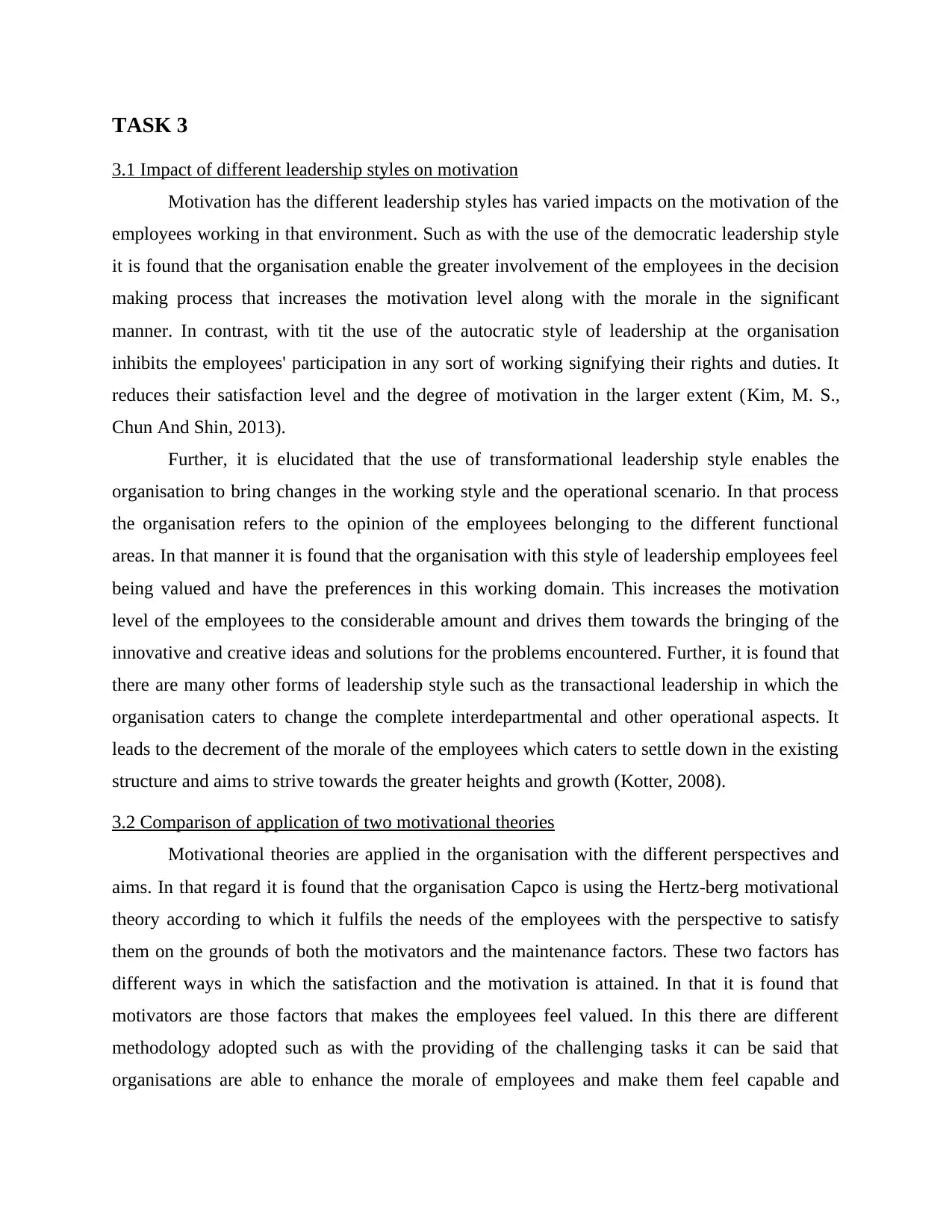
TASK 3
3.1 Impact of different leadership styles on motivation
Motivation has the different leadership styles has varied impacts on the motivation of the
employees working in that environment. Such as with the use of the democratic leadership style
it is found that the organisation enable the greater involvement of the employees in the decision
making process that increases the motivation level along with the morale in the significant
manner. In contrast, with tit the use of the autocratic style of leadership at the organisation
inhibits the employees' participation in any sort of working signifying their rights and duties. It
reduces their satisfaction level and the degree of motivation in the larger extent (Kim, M. S.,
Chun And Shin, 2013).
Further, it is elucidated that the use of transformational leadership style enables the
organisation to bring changes in the working style and the operational scenario. In that process
the organisation refers to the opinion of the employees belonging to the different functional
areas. In that manner it is found that the organisation with this style of leadership employees feel
being valued and have the preferences in this working domain. This increases the motivation
level of the employees to the considerable amount and drives them towards the bringing of the
innovative and creative ideas and solutions for the problems encountered. Further, it is found that
there are many other forms of leadership style such as the transactional leadership in which the
organisation caters to change the complete interdepartmental and other operational aspects. It
leads to the decrement of the morale of the employees which caters to settle down in the existing
structure and aims to strive towards the greater heights and growth (Kotter, 2008).
3.2 Comparison of application of two motivational theories
Motivational theories are applied in the organisation with the different perspectives and
aims. In that regard it is found that the organisation Capco is using the Hertz-berg motivational
theory according to which it fulfils the needs of the employees with the perspective to satisfy
them on the grounds of both the motivators and the maintenance factors. These two factors has
different ways in which the satisfaction and the motivation is attained. In that it is found that
motivators are those factors that makes the employees feel valued. In this there are different
methodology adopted such as with the providing of the challenging tasks it can be said that
organisations are able to enhance the morale of employees and make them feel capable and
3.1 Impact of different leadership styles on motivation
Motivation has the different leadership styles has varied impacts on the motivation of the
employees working in that environment. Such as with the use of the democratic leadership style
it is found that the organisation enable the greater involvement of the employees in the decision
making process that increases the motivation level along with the morale in the significant
manner. In contrast, with tit the use of the autocratic style of leadership at the organisation
inhibits the employees' participation in any sort of working signifying their rights and duties. It
reduces their satisfaction level and the degree of motivation in the larger extent (Kim, M. S.,
Chun And Shin, 2013).
Further, it is elucidated that the use of transformational leadership style enables the
organisation to bring changes in the working style and the operational scenario. In that process
the organisation refers to the opinion of the employees belonging to the different functional
areas. In that manner it is found that the organisation with this style of leadership employees feel
being valued and have the preferences in this working domain. This increases the motivation
level of the employees to the considerable amount and drives them towards the bringing of the
innovative and creative ideas and solutions for the problems encountered. Further, it is found that
there are many other forms of leadership style such as the transactional leadership in which the
organisation caters to change the complete interdepartmental and other operational aspects. It
leads to the decrement of the morale of the employees which caters to settle down in the existing
structure and aims to strive towards the greater heights and growth (Kotter, 2008).
3.2 Comparison of application of two motivational theories
Motivational theories are applied in the organisation with the different perspectives and
aims. In that regard it is found that the organisation Capco is using the Hertz-berg motivational
theory according to which it fulfils the needs of the employees with the perspective to satisfy
them on the grounds of both the motivators and the maintenance factors. These two factors has
different ways in which the satisfaction and the motivation is attained. In that it is found that
motivators are those factors that makes the employees feel valued. In this there are different
methodology adopted such as with the providing of the challenging tasks it can be said that
organisations are able to enhance the morale of employees and make them feel capable and
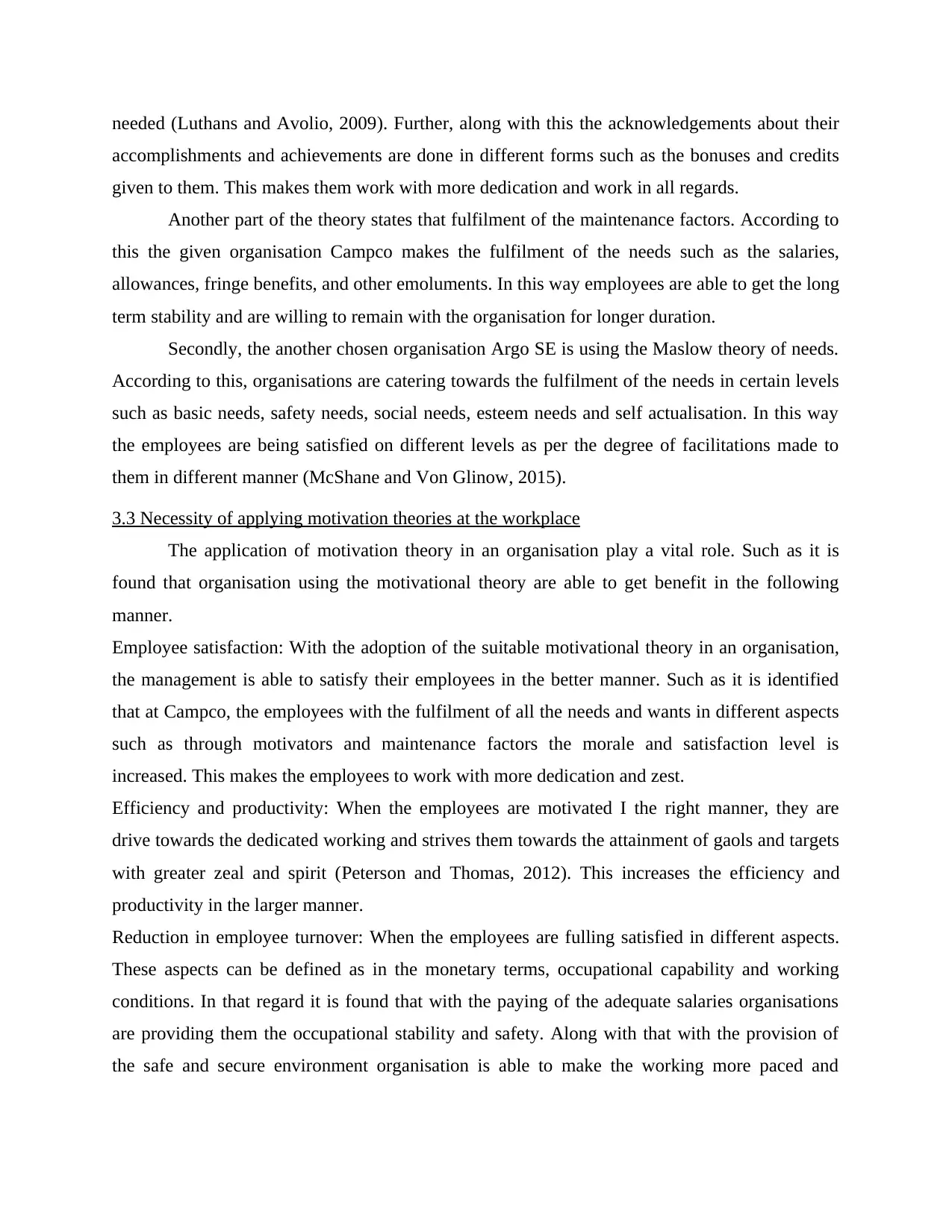
needed (Luthans and Avolio, 2009). Further, along with this the acknowledgements about their
accomplishments and achievements are done in different forms such as the bonuses and credits
given to them. This makes them work with more dedication and work in all regards.
Another part of the theory states that fulfilment of the maintenance factors. According to
this the given organisation Campco makes the fulfilment of the needs such as the salaries,
allowances, fringe benefits, and other emoluments. In this way employees are able to get the long
term stability and are willing to remain with the organisation for longer duration.
Secondly, the another chosen organisation Argo SE is using the Maslow theory of needs.
According to this, organisations are catering towards the fulfilment of the needs in certain levels
such as basic needs, safety needs, social needs, esteem needs and self actualisation. In this way
the employees are being satisfied on different levels as per the degree of facilitations made to
them in different manner (McShane and Von Glinow, 2015).
3.3 Necessity of applying motivation theories at the workplace
The application of motivation theory in an organisation play a vital role. Such as it is
found that organisation using the motivational theory are able to get benefit in the following
manner.
Employee satisfaction: With the adoption of the suitable motivational theory in an organisation,
the management is able to satisfy their employees in the better manner. Such as it is identified
that at Campco, the employees with the fulfilment of all the needs and wants in different aspects
such as through motivators and maintenance factors the morale and satisfaction level is
increased. This makes the employees to work with more dedication and zest.
Efficiency and productivity: When the employees are motivated I the right manner, they are
drive towards the dedicated working and strives them towards the attainment of gaols and targets
with greater zeal and spirit (Peterson and Thomas, 2012). This increases the efficiency and
productivity in the larger manner.
Reduction in employee turnover: When the employees are fulling satisfied in different aspects.
These aspects can be defined as in the monetary terms, occupational capability and working
conditions. In that regard it is found that with the paying of the adequate salaries organisations
are providing them the occupational stability and safety. Along with that with the provision of
the safe and secure environment organisation is able to make the working more paced and
accomplishments and achievements are done in different forms such as the bonuses and credits
given to them. This makes them work with more dedication and work in all regards.
Another part of the theory states that fulfilment of the maintenance factors. According to
this the given organisation Campco makes the fulfilment of the needs such as the salaries,
allowances, fringe benefits, and other emoluments. In this way employees are able to get the long
term stability and are willing to remain with the organisation for longer duration.
Secondly, the another chosen organisation Argo SE is using the Maslow theory of needs.
According to this, organisations are catering towards the fulfilment of the needs in certain levels
such as basic needs, safety needs, social needs, esteem needs and self actualisation. In this way
the employees are being satisfied on different levels as per the degree of facilitations made to
them in different manner (McShane and Von Glinow, 2015).
3.3 Necessity of applying motivation theories at the workplace
The application of motivation theory in an organisation play a vital role. Such as it is
found that organisation using the motivational theory are able to get benefit in the following
manner.
Employee satisfaction: With the adoption of the suitable motivational theory in an organisation,
the management is able to satisfy their employees in the better manner. Such as it is identified
that at Campco, the employees with the fulfilment of all the needs and wants in different aspects
such as through motivators and maintenance factors the morale and satisfaction level is
increased. This makes the employees to work with more dedication and zest.
Efficiency and productivity: When the employees are motivated I the right manner, they are
drive towards the dedicated working and strives them towards the attainment of gaols and targets
with greater zeal and spirit (Peterson and Thomas, 2012). This increases the efficiency and
productivity in the larger manner.
Reduction in employee turnover: When the employees are fulling satisfied in different aspects.
These aspects can be defined as in the monetary terms, occupational capability and working
conditions. In that regard it is found that with the paying of the adequate salaries organisations
are providing them the occupational stability and safety. Along with that with the provision of
the safe and secure environment organisation is able to make the working more paced and
⊘ This is a preview!⊘
Do you want full access?
Subscribe today to unlock all pages.

Trusted by 1+ million students worldwide
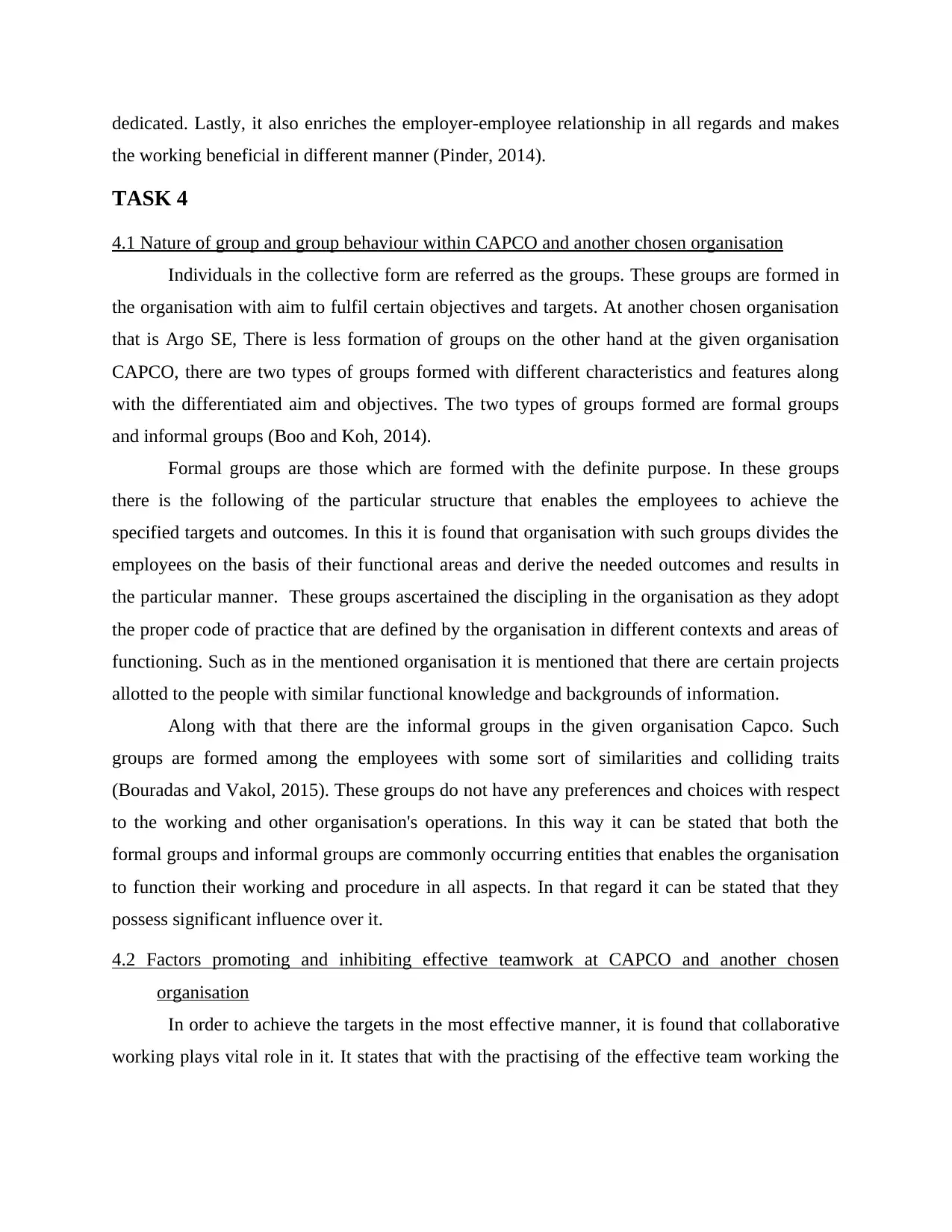
dedicated. Lastly, it also enriches the employer-employee relationship in all regards and makes
the working beneficial in different manner (Pinder, 2014).
TASK 4
4.1 Nature of group and group behaviour within CAPCO and another chosen organisation
Individuals in the collective form are referred as the groups. These groups are formed in
the organisation with aim to fulfil certain objectives and targets. At another chosen organisation
that is Argo SE, There is less formation of groups on the other hand at the given organisation
CAPCO, there are two types of groups formed with different characteristics and features along
with the differentiated aim and objectives. The two types of groups formed are formal groups
and informal groups (Boo and Koh, 2014).
Formal groups are those which are formed with the definite purpose. In these groups
there is the following of the particular structure that enables the employees to achieve the
specified targets and outcomes. In this it is found that organisation with such groups divides the
employees on the basis of their functional areas and derive the needed outcomes and results in
the particular manner. These groups ascertained the discipling in the organisation as they adopt
the proper code of practice that are defined by the organisation in different contexts and areas of
functioning. Such as in the mentioned organisation it is mentioned that there are certain projects
allotted to the people with similar functional knowledge and backgrounds of information.
Along with that there are the informal groups in the given organisation Capco. Such
groups are formed among the employees with some sort of similarities and colliding traits
(Bouradas and Vakol, 2015). These groups do not have any preferences and choices with respect
to the working and other organisation's operations. In this way it can be stated that both the
formal groups and informal groups are commonly occurring entities that enables the organisation
to function their working and procedure in all aspects. In that regard it can be stated that they
possess significant influence over it.
4.2 Factors promoting and inhibiting effective teamwork at CAPCO and another chosen
organisation
In order to achieve the targets in the most effective manner, it is found that collaborative
working plays vital role in it. It states that with the practising of the effective team working the
the working beneficial in different manner (Pinder, 2014).
TASK 4
4.1 Nature of group and group behaviour within CAPCO and another chosen organisation
Individuals in the collective form are referred as the groups. These groups are formed in
the organisation with aim to fulfil certain objectives and targets. At another chosen organisation
that is Argo SE, There is less formation of groups on the other hand at the given organisation
CAPCO, there are two types of groups formed with different characteristics and features along
with the differentiated aim and objectives. The two types of groups formed are formal groups
and informal groups (Boo and Koh, 2014).
Formal groups are those which are formed with the definite purpose. In these groups
there is the following of the particular structure that enables the employees to achieve the
specified targets and outcomes. In this it is found that organisation with such groups divides the
employees on the basis of their functional areas and derive the needed outcomes and results in
the particular manner. These groups ascertained the discipling in the organisation as they adopt
the proper code of practice that are defined by the organisation in different contexts and areas of
functioning. Such as in the mentioned organisation it is mentioned that there are certain projects
allotted to the people with similar functional knowledge and backgrounds of information.
Along with that there are the informal groups in the given organisation Capco. Such
groups are formed among the employees with some sort of similarities and colliding traits
(Bouradas and Vakol, 2015). These groups do not have any preferences and choices with respect
to the working and other organisation's operations. In this way it can be stated that both the
formal groups and informal groups are commonly occurring entities that enables the organisation
to function their working and procedure in all aspects. In that regard it can be stated that they
possess significant influence over it.
4.2 Factors promoting and inhibiting effective teamwork at CAPCO and another chosen
organisation
In order to achieve the targets in the most effective manner, it is found that collaborative
working plays vital role in it. It states that with the practising of the effective team working the
Paraphrase This Document
Need a fresh take? Get an instant paraphrase of this document with our AI Paraphraser
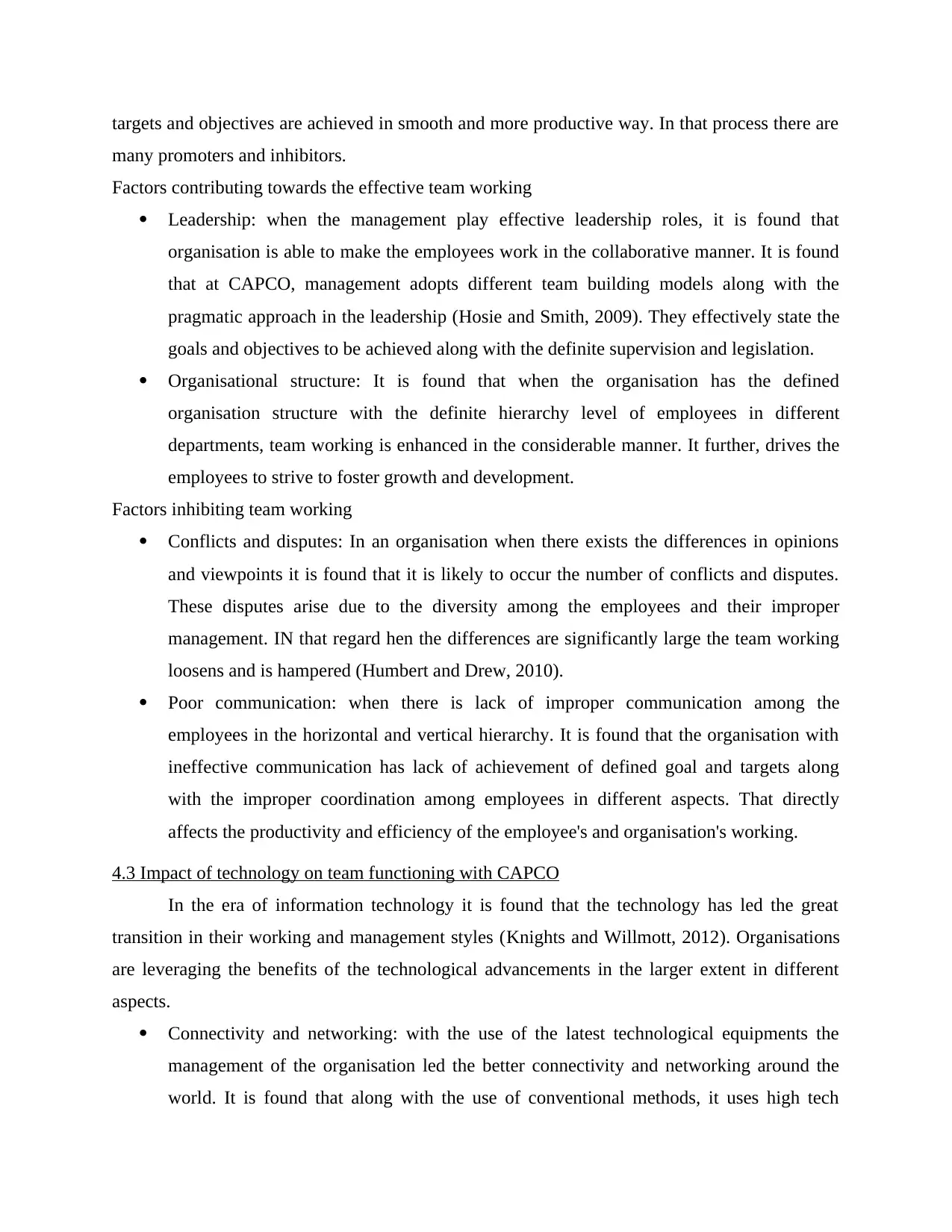
targets and objectives are achieved in smooth and more productive way. In that process there are
many promoters and inhibitors.
Factors contributing towards the effective team working
Leadership: when the management play effective leadership roles, it is found that
organisation is able to make the employees work in the collaborative manner. It is found
that at CAPCO, management adopts different team building models along with the
pragmatic approach in the leadership (Hosie and Smith, 2009). They effectively state the
goals and objectives to be achieved along with the definite supervision and legislation.
Organisational structure: It is found that when the organisation has the defined
organisation structure with the definite hierarchy level of employees in different
departments, team working is enhanced in the considerable manner. It further, drives the
employees to strive to foster growth and development.
Factors inhibiting team working
Conflicts and disputes: In an organisation when there exists the differences in opinions
and viewpoints it is found that it is likely to occur the number of conflicts and disputes.
These disputes arise due to the diversity among the employees and their improper
management. IN that regard hen the differences are significantly large the team working
loosens and is hampered (Humbert and Drew, 2010).
Poor communication: when there is lack of improper communication among the
employees in the horizontal and vertical hierarchy. It is found that the organisation with
ineffective communication has lack of achievement of defined goal and targets along
with the improper coordination among employees in different aspects. That directly
affects the productivity and efficiency of the employee's and organisation's working.
4.3 Impact of technology on team functioning with CAPCO
In the era of information technology it is found that the technology has led the great
transition in their working and management styles (Knights and Willmott, 2012). Organisations
are leveraging the benefits of the technological advancements in the larger extent in different
aspects.
Connectivity and networking: with the use of the latest technological equipments the
management of the organisation led the better connectivity and networking around the
world. It is found that along with the use of conventional methods, it uses high tech
many promoters and inhibitors.
Factors contributing towards the effective team working
Leadership: when the management play effective leadership roles, it is found that
organisation is able to make the employees work in the collaborative manner. It is found
that at CAPCO, management adopts different team building models along with the
pragmatic approach in the leadership (Hosie and Smith, 2009). They effectively state the
goals and objectives to be achieved along with the definite supervision and legislation.
Organisational structure: It is found that when the organisation has the defined
organisation structure with the definite hierarchy level of employees in different
departments, team working is enhanced in the considerable manner. It further, drives the
employees to strive to foster growth and development.
Factors inhibiting team working
Conflicts and disputes: In an organisation when there exists the differences in opinions
and viewpoints it is found that it is likely to occur the number of conflicts and disputes.
These disputes arise due to the diversity among the employees and their improper
management. IN that regard hen the differences are significantly large the team working
loosens and is hampered (Humbert and Drew, 2010).
Poor communication: when there is lack of improper communication among the
employees in the horizontal and vertical hierarchy. It is found that the organisation with
ineffective communication has lack of achievement of defined goal and targets along
with the improper coordination among employees in different aspects. That directly
affects the productivity and efficiency of the employee's and organisation's working.
4.3 Impact of technology on team functioning with CAPCO
In the era of information technology it is found that the technology has led the great
transition in their working and management styles (Knights and Willmott, 2012). Organisations
are leveraging the benefits of the technological advancements in the larger extent in different
aspects.
Connectivity and networking: with the use of the latest technological equipments the
management of the organisation led the better connectivity and networking around the
world. It is found that along with the use of conventional methods, it uses high tech
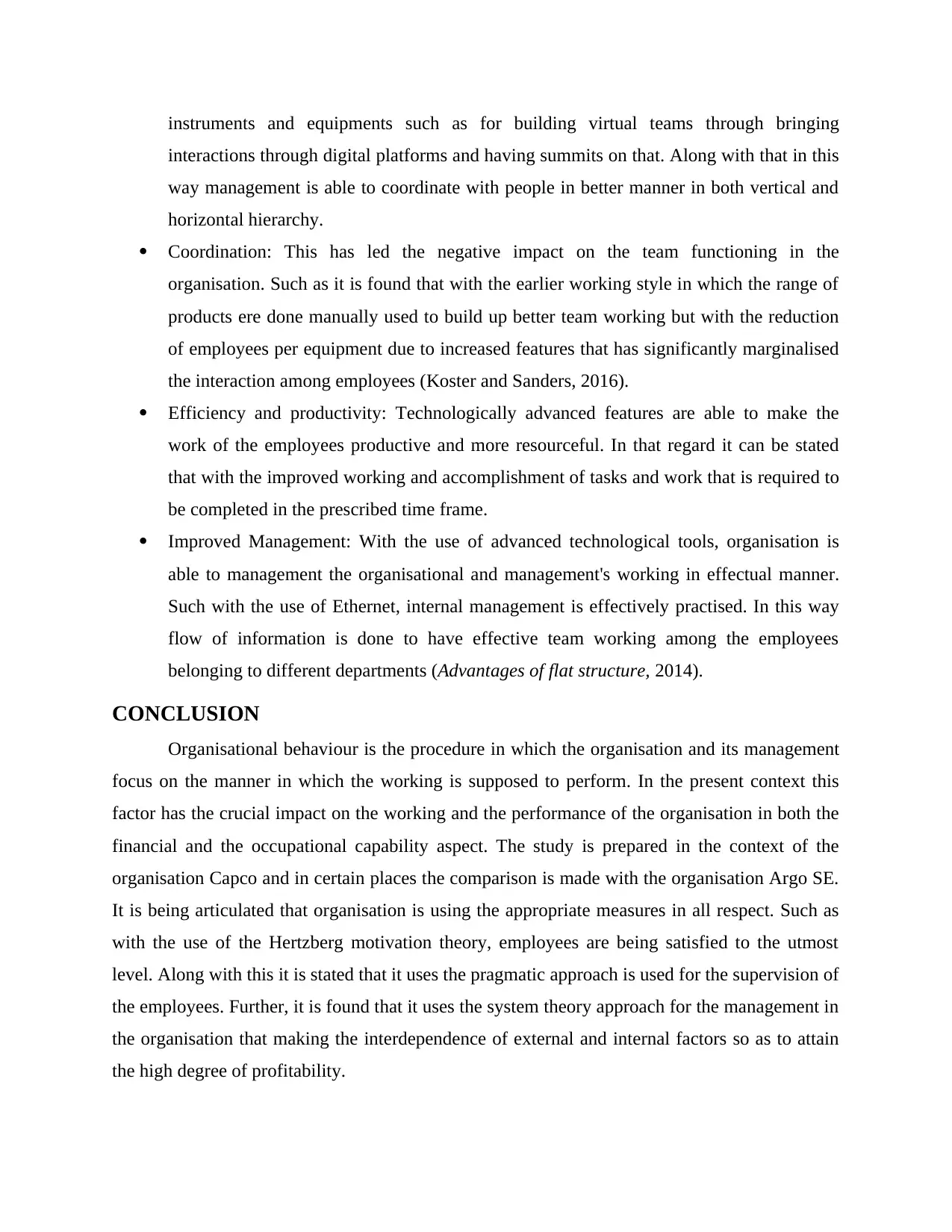
instruments and equipments such as for building virtual teams through bringing
interactions through digital platforms and having summits on that. Along with that in this
way management is able to coordinate with people in better manner in both vertical and
horizontal hierarchy.
Coordination: This has led the negative impact on the team functioning in the
organisation. Such as it is found that with the earlier working style in which the range of
products ere done manually used to build up better team working but with the reduction
of employees per equipment due to increased features that has significantly marginalised
the interaction among employees (Koster and Sanders, 2016).
Efficiency and productivity: Technologically advanced features are able to make the
work of the employees productive and more resourceful. In that regard it can be stated
that with the improved working and accomplishment of tasks and work that is required to
be completed in the prescribed time frame.
Improved Management: With the use of advanced technological tools, organisation is
able to management the organisational and management's working in effectual manner.
Such with the use of Ethernet, internal management is effectively practised. In this way
flow of information is done to have effective team working among the employees
belonging to different departments (Advantages of flat structure, 2014).
CONCLUSION
Organisational behaviour is the procedure in which the organisation and its management
focus on the manner in which the working is supposed to perform. In the present context this
factor has the crucial impact on the working and the performance of the organisation in both the
financial and the occupational capability aspect. The study is prepared in the context of the
organisation Capco and in certain places the comparison is made with the organisation Argo SE.
It is being articulated that organisation is using the appropriate measures in all respect. Such as
with the use of the Hertzberg motivation theory, employees are being satisfied to the utmost
level. Along with this it is stated that it uses the pragmatic approach is used for the supervision of
the employees. Further, it is found that it uses the system theory approach for the management in
the organisation that making the interdependence of external and internal factors so as to attain
the high degree of profitability.
interactions through digital platforms and having summits on that. Along with that in this
way management is able to coordinate with people in better manner in both vertical and
horizontal hierarchy.
Coordination: This has led the negative impact on the team functioning in the
organisation. Such as it is found that with the earlier working style in which the range of
products ere done manually used to build up better team working but with the reduction
of employees per equipment due to increased features that has significantly marginalised
the interaction among employees (Koster and Sanders, 2016).
Efficiency and productivity: Technologically advanced features are able to make the
work of the employees productive and more resourceful. In that regard it can be stated
that with the improved working and accomplishment of tasks and work that is required to
be completed in the prescribed time frame.
Improved Management: With the use of advanced technological tools, organisation is
able to management the organisational and management's working in effectual manner.
Such with the use of Ethernet, internal management is effectively practised. In this way
flow of information is done to have effective team working among the employees
belonging to different departments (Advantages of flat structure, 2014).
CONCLUSION
Organisational behaviour is the procedure in which the organisation and its management
focus on the manner in which the working is supposed to perform. In the present context this
factor has the crucial impact on the working and the performance of the organisation in both the
financial and the occupational capability aspect. The study is prepared in the context of the
organisation Capco and in certain places the comparison is made with the organisation Argo SE.
It is being articulated that organisation is using the appropriate measures in all respect. Such as
with the use of the Hertzberg motivation theory, employees are being satisfied to the utmost
level. Along with this it is stated that it uses the pragmatic approach is used for the supervision of
the employees. Further, it is found that it uses the system theory approach for the management in
the organisation that making the interdependence of external and internal factors so as to attain
the high degree of profitability.
⊘ This is a preview!⊘
Do you want full access?
Subscribe today to unlock all pages.

Trusted by 1+ million students worldwide
1 out of 14
Related Documents
Your All-in-One AI-Powered Toolkit for Academic Success.
+13062052269
info@desklib.com
Available 24*7 on WhatsApp / Email
![[object Object]](/_next/static/media/star-bottom.7253800d.svg)
Unlock your academic potential
Copyright © 2020–2025 A2Z Services. All Rights Reserved. Developed and managed by ZUCOL.





